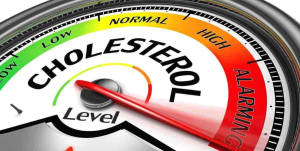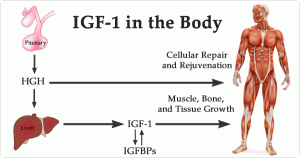The Importance of Maintaining Normal Physiological Estrogen Levels
Estrogen: Kill it or Leave it?
As this subtopic has been briefly touched upon previously in the introduction, all too often within the anabolic steroid using bodybuilding and athletic community do aspects of nutrition, training, supplement, and drug use succumb to extremism from both ends of the spectrum. This is indeed a characteristic that can be seen across society in general, and in this case, we are concerned with Estrogen. While Estrogen is indeed a concern with anabolic steroid use, there are those who promote and advocate the complete reduction and elimination of all Estrogen levels in the body during cycles of anabolic steroids (and even off-cycle as well), and there are also those who advocate the other end of the extreme: allowing Estrogen levels during anabolic steroid use to rise wildly without care. The human body is always actively attempting to maintain homeostasis. Homeostasis as it applies to biology and physiology is a system whereby variables are regulated in an effort to ensure that internal conditions are stable within the organism’s limits.
When individuals decide to engage in an anabolic steroid cycle, the body will attempt to maintain homeostasis and reduce its own endogenous output of androgens in light of the large amount of exogenous androgens entering the system by way of shutting off or drastically reducing the activity of the HPTA (Hypothalamic Pituitary Testicular Axis)[1]. But that isn’t the only attempt to maintain endocrine homeostasis, as any aromatizable androgens being administered exogenously will interact with the aromatase enzyme and result in an increase in blood plasma levels of Estrogen. This is the body’s effort to attempt to reduce excessive circulating levels of androgens, as well as maintain a level of hormonal balance.
Positive Effects of Estrogen
All too often, Estrogen, much like Cortisol, is mislabeled as being an ‘evil’ hormone. While Estrogen in very high amounts has the potential to cause a number of undesirable effects on the body, it is quite beneficial in a number of areas in the body, some of which are:
– Cholesterol values and cardiovascular function: there is a significant amount of evidence to support the beneficial properties that Estrogen has on the cardiovascular system as a whole. Pre-menopausal females are known for having a lower risk of cardiovascular disease than men and post-menopausal women[2], and it has been observed in studies that E2 (Estradiol) in normal physiological levels in men can provide an identical amount of benefit towards cardiovascular protection that it does in females[3]. Additionally, evidence also supports the therapeutic use of Estrogen where cardiovascular physiology is concerned, as evidenced by the improvement of cardiovascular function in male-female transsexuals, and the fact that arterial reactivity (elasticity of the arteries) is increased in males that are administered high-dose Estrogen[4]. Furthermore, the reduction of Estrogen has demonstrated detrimental impacts on cholesterol levels especially during anabolic steroid administration. One study administered 280mg of Testosterone Enanthate weekly for 12 weeks, and while cholesterol values predictably dropped slightly in test subjects, their cholesterol profiles had later changed for the worse when an aromatase inhibitor was included, which resulted in a significant 25% drop in HDL cholesterol[5]. Estrogen is paramount for the proper functioning of the cardiovascular system, which is something that is already under duress during anabolic steroid cycles.

Estrogen and cholesterol levels
– Muscle growth, Growth Hormone, and IGF-1: Estrogen is believed to have a hand in the proper functioning and regulation of human growth hormone (HGH) and Insulin-like Growth Factor 1 (IGF-1), which is known as a very potent anabolic peptide in muscle tissue that is synthesized and secreted from the liver. HGH and IGF-1 in particular are responsible for a number of muscle anabolism promoting effects. These include the promotion of nitrogen retention and protein synthesis, as well as cell hyperplasia (myonuclei proliferation). Reduced E levels result in a reduction of circulating IGF-1, and thereby has a negative effect on overall muscle anabolism as evidenced by a study that investigated the effects that an anti-estrogen, Nolvadex (Tamoxifen), had on these functions[6]. Further studies on Nolvadex’s suppressive effects on IGF-1 (through it’s anti-estrogenic effects) were conducted, and found that these suppressive effects on IGF-1 persisted even in the presence of the administration of the anabolic steroid Testosterone[7]. That study not only investigated Nolvadex’s suppressive effects on IGF-1 with the administration of Testosterone, but also the effects of Testosterone on IGF-1 without Nolvadex. The results of the study demonstrated that IGF-1 levels increased when Testosterone was administered alone, and a notable decline of IGF-1 levels when Nolvadex was administered, with and without Testosterone. To top off all of this, there is also evidence that Estrogen has a positive effect on the androgen receptor, in that the number of androgen receptors in muscle tissue increases in the presence of Estrogen, as well as slowing down the rate of androgen receptor breakdown[8]. All of this information obviously points us to the conclusion that normal circulating blood plasma levels of Estrogen are indeed very necessary for the normal functioning of muscle growth.

Estrogen and IGF-1 on muscle growth
– Sexual function, libido, and fertility: the degree of impact that Estrogen (as well as a lack of it) has on the sexual function and fertility of an organism is astounding. The presence of normal blood plasma levels of Estrogen is essential for the proper functioning of the libido and fertility alike, and the reduction of Estrogen below normal ranges can have a significant negative impact in this area of physiological function. Male libido is dependent on many factors, including: Estrogen and Testosterone, as well as other molecules, such as neurotransmitters. One very important study demonstrated that both Testosterone and Estrogen are both equally important in maintaining sexual function, and that those subjects who were given an aromatase inhibitor to halt aromatization expressed a significant reduction in sexual desire and libido[9]. This is also an effect of low Estrogen levels that many anabolic steroid users can anecdotally attest to, via the use of high doses of aromatase inhibitors such as Letrozole (Femara), Arimidex (Anastrozole), or Aromasin (Exemestane). Furthermore, other studies have demonstrated that Estrogen plays an important role in regulating a particular stage in sperm maturation and development in the gonads, and that the disruption of Estrogen levels results in temporary infertility until normal Estrogen levels can be restored[10]. Normal physiological blood plasma levels of Estrogen alongside healthy levels of androgens are very necessary for the proper sexual function of men.

Estrogen plays a role in sexual function
– Prevention of Lethargy: It has been previously mentioned in the introduction that the aromatase enzyme is found to be in considerable concentration in the central nervous system. Many anabolic steroid using athletes and bodybuilders have complained of massive amounts of lethargy when using strong aromatase inhibitors to significantly reduce circulating levels of Estrogen in the body during an anabolic steroid cycle. This has often been dubbed “steroid fatigue” or “Estrogen lethargy”. Going back to the activity of Estrogen in the central nervous system, it is a confirmed fact that Estrogen plays some important roles in the central nervous system, particularly in the regulation of the neurotransmitter serotonin, which is very important in the maintenance of a healthy and normal functioning sleep/wake cycle and wakefulness[11] [12]. Disruptions of the neurotransmitter serotonin have demonstrated to have associations with chronic fatigue in organisms[13] [14]. In connection with this, the reduction of Estrogen (E2) in post-menopausal women has resulted in chronic fatigue[15], and the use of many different aromatase inhibitors have clinically demonstrated the same chronic fatigue in a variety of patients who have used them[16] [17] [18] [19], as has also been the case anecdotally with anabolic steroid users who have utilized the same drugs for off-label purposes during steroid use in order to combat potential estrogenic side effects. Maintaining normal physiological ranges of Estrogen during anabolic steroid use is crucial to maintaining a normal state of wakefulness.
When to Drop Estrogen and For How Long?
The question by many readers at this point must be: so when do we lower Estrogen levels for and for how long? The answer is not so simple, but it is not so complex either. First of all, if possible, bloodwork through a physician should always be conducted whenever running an anabolic steroid cycle or any aromatase inhibitors. This would ensure as close as possible to pinpoint accuracy in what the anabolic steroid user is doing, and solid numbers provided through bloodwork should be used. It is impossible for any individual to ‘feel’ where their Estradiol (E2) levels are at in their bloodstream. As Estradiol (E2) is the primary Estrogen product of aromatization, it is what we are concerned with in terms of anabolic steroid users and males in general, the normal and healthy rage of Estradiol in blood plasma as established by the medical establishment is 14 – 55 pg/mL. Note that the units of measurement might be different depending on the units used in different countries, though picograms per mL (pg/mL) is the standard in American medicine.
Without access to bloodwork, the only guide as to where an individual’s Estrogen levels are might only be through signs and symptoms, which will be discussed in the next section of this article, Estrogen side effects.
Lastly, if Estrogen levels must be reduced through the use of an aromatase inhibitor, Estrogen levels should not reach critically low levels for more than is minimally necessary to mitigate any Estrogenic side effects (or for no more than one week’s time). Chronic low serum levels of Estrogen can and will result in a whole host of disruptions in normal physiological function, many of which can become extremely uncomfortable and/or alarming health hazards for the individual. Many competitive and professional bodybuilders will employ the use of a strong aromatase inhibitor in the days leading up to a competition show, but it is important to understand that this is not practiced for more than a few days, and is often extremely discomforting for the bodybuilder doing so.
Medical References:
[1] A combined regimen of cyproterone acetate and testosterone enanthate as a potentially highly effective male contraceptive. C Meriggola et al. J Clin Endocrinol Metab 81(8) 3018-23, 1996.
[2] Rosano GM, Panina G (1999). “Oestrogens and the heart”. Therapie 54 (3): 381–5. PMID 10500455.
[3] Alliomaki K et al. 1996. Clinical features of primary ovarian failure caused by a point mutation in the follicle-stimulating hormone receptor gene. J Clin Endocrinol Metab. 81:3722-6.
[4] Espey LL and H Lipner. 1994. Ovulation. In: E. Knobil and J Neill, eds. The physiology of reproduction, 2nd edn. New York: Raven Press, pp. 725-80.
[5] High-density lipoprotein choilesterol is not decreased if an aromatizable androgen is administered. Friedl K, Hannan C et al. Metabolism 39(1) 1990.
[6] Influence of tamoxifen, aminoglutethimide and goserelin on human plasma IGF-l levels in breast cancer patients. J steroid Biochem Mol Bio 41 :5413,1992.
[7] Activation of the somatotropic axis by testosterone in adult males: Evidence for the role of aromatization. J Clin. Endocrinol Metab 76:1407-12 1993.
[8] Modulation of the cytosolic androgen receptor in striated muscle by sex steroids. Endocrinology. 1984 Sep;115(3):862-6.
[9] Malnick S, Somin M, Goland S. Gonadal steroids and body composition, strength, and sexual function in men. N Engl J Med. 2013 Dec 19;369(25):2456. doi: 10.1056/NEJMc1313169#SA4.
[10] Breedlove, SM and AP Arnold. 1980. Hormone accumulation in a sexually dimorphic motor nucleus of the rat spinal cord. Science 210:564-6.
[11] Zenab Amin et al. Effect of estrogen-serotonin interactions on mood and cognition. Behav Cogn Neurosci Reviews 4(1) 2005:43-58.
[12] Chiara M Portas et al. Serotonin and the sleep/wake cycle: special emphasis on miscodialysis studies. Progress in Neurology 60(200) 13-35.
[13] Reduction of serotonin transporters of patients with chronic fatigue syndrome. Neuroreport 2004 Dec 3;15(17):2571-4.
[14] Narita M et al. Association between serotonin transporter gene polymorphism and chronic fatigue syndrome. Biochem Biophys Res Commun 2003 Nov 14;311 (2)264-6.
[15] Dickerson LM et al. Premenstrual Syndrome. Am Fam Physician 2003 Apr 15;67(8):1743-52.
[16] Phase” trial of anastrozole in women with asymptomatic mullerian cancer. Gynecol Oncol. 2003 Dec;91 (3):596-602.
[17] Letrozole. A review of its use in postmenopausal women with advanced breast cancer. Drugs. 1998 Dec;56(6):1125-40. Review.
[18] Exemestane: a review of its clinical efficacy and safety. Breast. 2001 Jun;10(3):198-208.
[19] A study of fadrozole, a new aromatase inhibitor, in postmenopausal women with advanced metastatic breast cancer. J Clin Oncol. 1992
Jan;10(l):111-6.





